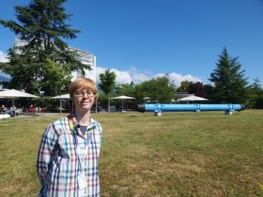A career in the construction industry is not an option that springs to mind for many physics graduates, but physicists play a fascinating and important role in the design of new buildings, bridges and roads, as Andrew Eastwell explains

When I left university in 1975 having completed a degree in applied physics, embarking on a long-term career was pretty much the last thing on my mind. Exhausted by exams, and with the summer of 1975 shaping up to be a real scorcher, the prospect of beaches, sunshine and sailing seemed much more attractive. So I took a few months off — think of it as a delayed gap year.
Come the winter, however, with the beaches deserted and funds dispiritingly low, I looked in my local paper for something temporary to do while I considered how best to put my shiny new degree to good use. The Building Services Research and Information Association — a small research and development outfit in Bracknell — was looking for graduates to carry out laboratory experimentation into the comfort issues associated with buildings. Although the money was not great, the job was certainly interesting and would do fine as a stopgap. As it happened, the job was rather better than that and 33 years later I am chief executive of that research association, which is now the company known as BSIRA.
When I began my career, it was clear that while construction was a big industry (it now accounts for about 10% of the UK’s Gross Domestic Product), on the whole it was not at the forefront of technology and did not have many graduates — especially those with a background in science or technology — working in it. This meant that I, as a physicist, suddenly found myself working with very senior people at major UK and international companies, as well as gaining immediate access to some of the best people in the industry through in the professional organizations such as the Chartered Institute of Building Services Engineering. I was able to make a difference almost immediately.
For example, my first task was to develop a method for testing “whole house ventilation heat recovery devices”. This was quite complex, since it required the airflow volume, moisture content, temperature and electrical load to be measured in each of four positions simultaneously. A curiosity 30 years ago, this research is now essential as we work towards “zero carbon” homes. I was helped by having an employer that wanted junior employees to put their names to their work rather than hiding under their supervisors’ titles, and also by colleagues who were sociable, supportive and at the top of their game.
Diverse sector
The construction industry is involved in everything from motorways and bridges (civil construction) through to schools, hospitals, offices and homes (the built environment). Within these sectors there are designers (architects, structural engineers, building-services consultants and so on) and contractors, who actually put things together on-site. This latter group consists of the main contractors that erect the structures and specialist contractors that put in all the plant and equipment that make buildings comfortable and safe to live in. It is at the latter end of the spectrum that BSRIA works.
Founded in the mid-1950s by a group of companies that wanted to collaborate in research and development, BSRIA is one of about 50 research associations (RAs) in the UK that each deal with a particular market sector. For example, there are RAs for shoes, timber, drop forging and even (my second favourite) Scotch whisky. They are where industrial companies come together to do collaborative research, and over the years they have transformed from membership subscription-based organizations to wholly self-funded enterprises. Nevertheless, many research associations, including BSRIA, continue to operate a membership base and to facilitate collaborative efforts both in research and on a more political level.
In recent years the role of the built-environment engineer and contractor has changed radically. The escalating need to create buildings that produce very low or zero carbon-dioxide emissions has created new challenges that are taxing the very best brains. Indeed, we have to meet targets set by the UK government that all new houses built in the country will be “zero carbon” by 2016, with all non-domestic buildings following suit by 2019. You just have to look at your own home, with its heating, hot water and lighting needs, to appreciate just how difficult this is going to be to achieve if the occupants of these buildings are also going to be comfortable and healthy.
If this is problematic for new buildings, then it is even more difficult to achieve in existing buildings — and it is these that can make the real difference to carbon emissions. Roughly half of all carbon emissions come from buildings and their uses but only 1% of these buildings are newly constructed, while just 2% have some form of refurbishment each year. In other words, 97% of buildings have nothing done to them to improve their performance.
Building physics can do something about this by trying to understand the complex interactions of energy flows around structures. This involves resolving the influences of highly multivariate interactions and creating models that can eventually be used to build new structures. These tasks are well suited to people with a physics background, and there is a wonderful future ahead for bright and committed people who want to make a difference.
Path to success
BSRIA is not a large organization — it currently has 150 employees — and about half of the staff have numerate degrees, including mechanical engineering, aeronautical engineering and physics. We work both with those who are at the sharp end of invention, such as universities and other research institutions, and those who prefer to be a little further away from the cutting edge. Construction companies and their clients, for example, are highly risk averse, so it is our role to take innovation and create proven, derisked processes that can be used with confidence by constructors. As a result, both the company and its individual staff have a high exposure in the trade press and at conferences, and they have a lot of contact with the policy-makers in government. It is this diversity of activity that has made mine such a rewarding job.
I have now been chief executive of BSRIA for 10 years, having worked up through a variety of posts within the company. I started as a supervised project engineer, then progressed to running a small section of five people, and later a group of four sections. I took up the role of technical director and joined the first board of directors following a restructuring of the business in 1989 before being appointed to the top job in 1998.
Since I joined, the firm’s horizons have widened considerably — for example, in March of this year I opened a new office in Beijing, which employs five local staff. China is likely to undertake nearly half of the entire world’s activity in construction within the next decade and its government is anxious to ensure that its carbon footprint does not rise at the same rate. With many overseas companies now working there, the opportunities for transferring expertise are significant, although this expansion also presents many cultural and economic challenges for the firm. It is this mix of technology and business that has made my career at BSRIA such a delightful experience. Despite having been with the organization for 33 years, it seems like only yesterday since the beaches started to empty and the rain stopped play.



